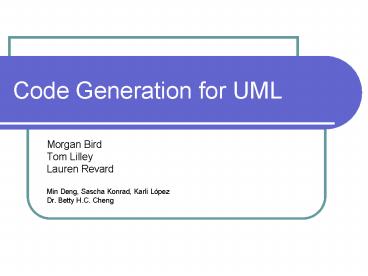Code Generation for UML PowerPoint PPT Presentation
Title: Code Generation for UML
1
Code Generation for UML
- Morgan Bird
- Tom Lilley
- Lauren Revard
- Min Deng, Sascha Konrad, Karli López
- Dr. Betty H.C. Cheng
2
Outline
- Background
- Project Overview
- Approach
- Validation
- Conclusions
- Demonstration
3
Background
4
Unified Modeling Language
- Abbreviated UML
- Models software systems using standardized
graphical notation - De facto standard
- Model-driven development
- Syntax well-defined Semantics not well defined
- Challenge
- Provide formal semantics for UML
- Create code generator that will define semantics
in terms of a particular language
5
Quantum Programming
- Reactive systems
- Event-driven
- Events can happen at any time
- Difficult to understand and code
6
Quantum Programming
- Abbreviated QP
- New programming paradigm
- Built-in support for creating reactive systems
- New features
- HSM design pattern
- asynchronous communication
- increases level of abstraction
- Allows programmer to model reactive systems
directly
7
Embedded C
- Abbreviated EC
- Subset of C created for embedded systems
applications - Differences between C and EC
- EC does not support
- Multiple inheritance
- Exceptions
- Templates
- Namespace
- Simplified language to reduce size of programs
8
Project Overview
9
GOAL
- Create a code generator that converts a UML
state diagram to EC code
10
How its Done
- Models created with Rational XDE, exported as XMI
files - Code generation program parses XMI files, creates
a tree that contains classes such as Transition
or CompositeState - Visitor function traverses the tree and outputs
EC code that corresponds to the model
11
Our Work
- Most elements of the code generator were provided
to us - Our implementation The visitor function
- Written in Java
- Created on the Eclipse platform
- Example
12
(No Transcript)
13
Example
- enum QHsmTstSignals
- A_SIG _Q_USER_SIG,
- B_SIG, C_SIG, D_SIG, E_SIG, F_SIG, G_SIG, H_SIG
- class QHsmTst() public QHsm
- public
- QHsmTst() QHsm((QPseudoState)initial)
- protected
- void initial (QEvent const e)
- QSTATE s0(QEvent const e)
- QSTATE s1(QEvent const e)
- QSTATE s11(QEvent const e)
- QSTATE s2(QEvent const e)
- QSTATE s21(QEvent const e)
- QSTATE s211(QEvent const e)
- private
- int myFoo
14
Example
- void QHsmTstinitial(QEvent const )
- printf(top-INIT)
- myFoo 0
- Q_INIT(QHsmTsts0)
- QSTATE QHsmTsts0(QEvent const e)
- switch (e-gtsig)
- case Q_ENTRY_SIG printf(s0-ENTRY) return(0)
- case Q_EXIT_SIG printf(s0-EXIT) return(0)
- case Q_INIT_SIG printf(s0-INIT)
Q_INIT(QHsmTsts1) return(0) - case E_SIG printf(s0-E) Q_TRAN(QHsmTsts21
1) return 0 - return (QSTATE) QHsmTsttop
15
Approach
16
Creating the Tree
- Convert the XMI file into a data structure that
the application can use - Based on UML metamodel of state diagram
- Consists of a tree of items that inherit from the
abstract class ModelElement
17
(No Transcript)
18
Using the Visitor Pattern
- Use the tree to create EC code
- Implemented with a visitor function
- Each node in the tree implements accept() method,
which calls a class-specific visitor function
19
Using the Visitor Pattern
- // This is the base Node class where all other
nodes - // inherit the accept routine
- public abstract class Node
- public void accept(Visitor v)
- // These definition of a node we might find
- // in our structure.
- public class ActionNode extends Node
- public void accept(Visitor v)
- v.visitActionNode(this)
- // This is the base Visitor class where all other
nodes - // inherit the proper visit Routines called by
the nodes. - public abstract class Visitor
- public void visitStateNode(StateNode n)
- public void visitTransitionNode(TransitionNode
n) - public void visitActionNode(ActionNode n)
20
Rules
- The visitor function will take the data in the
node and convert it into code - Requires a set of formalized rules for each
object - Rules will be language-specific
- Include
- Overview
- Names and definitions of all variables and terms
that will be used - Pseudocode for each visitor function
- Sample output for each visitor function
21
Rules (example psuedocode)
- //add transitionName to the enumeration of
signals - if transitionData is empty
- transitionData transitionName
- transitionData Q_USER_SIG
- else
- transitionData ,
- transitionData transitionName
- if guard exists
- stateData if (
- visitGuard(guard)
- stateData )
- // any actions given in the transition
- stateBody codeBody
- stateBody Q_TRAN(QHsmTest
- stateBody target-gtname
- stateBody )
- stateBody return 0
22
Validation
23
Testing Phase
- Two sample models
- Practical Statecharts in EC example
- Academic example
- Encompasses all basic elements
- Composite states
- Transitions
- Guards
- Ect
- Eaton Corp. example
- Real world test
- Remote wireless sensors
24
Practical Statecharts Model
25
Eaton Corp. Model
26
Conclusions
27
Program
- Completed application is capable of taking an XMI
of a moderately complex statechart and producing
EC code - Can be used to test validity of statechart
- Can be used to implement the system in the model
28
Our Biggest Challenges
- Amount of time
- Grasping new concepts
- Quantum Programming
- Automated code generation
- Understanding and extending pre-existing code
- Standardizing code generation rules for a variety
of implementations
29
Future Improvements
- Doesnt handle some features of state diagrams
- Concurrent states
- Event queues
- Only supports one language (EC)
- Only supports one kind of UML diagram (state
diagrams)
30
Demonstration

